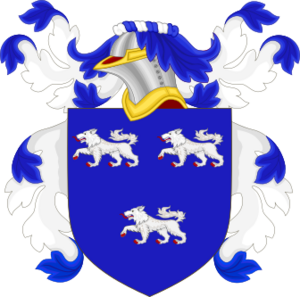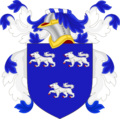William Crowne facts for kids
William Crowne (1617–1682) had a very interesting life! He was an officer who helped create coats of arms, a member of Parliament, and a colonel during the English Civil War. He also owned a part of the English colony of Nova Scotia. He was the father of a famous writer named John Crowne.
Early Life and Family
We don't know much about William Crowne's early life or exactly when he was born. Some records say 1608, others 1617, or even 1620.
When he was a young man, he traveled to Germany with his boss, the Earl of Arundel. Crowne wrote a book about his journey called "A true relation of all the remarkable places and passages observed in the travels of the right honourable Thomas Lord Hovvard, Earle of Arundell and Surrey..."
The Earl of Arundel was in charge of who got jobs at the College of Arms. This is a place in England where experts design and record coats of arms and family histories. In 1638, the Earl gave Crowne a job as a Rouge Dragon Pursuivant. This was one of the junior officer roles at the College of Arms. Crowne kept this job even when he lived in North America, finally leaving it in 1661.
Between 1635 and 1640, William Crowne married Agnes Watts. She was the sister of Humphrey Mackworth, who later became an important leader during the English Civil War. William and Agnes had three children. Their oldest son, John Crowne, grew up to be a well-known writer for plays.
During the Civil War
When the English Civil War began, William Crowne supported the Parliament. From 1641 to at least 1644, he worked as a secretary for a leader named Basil Feilding. By 1649, he was working for his brother-in-law, Humphrey Mackworth.
Crowne became a captain in the army on April 2, 1650. Just over two weeks later, he was promoted to lieutenant-colonel, still serving under his brother-in-law. In 1654, he was chosen to be a Member of Parliament (MP) for a town called Bridgnorth. An MP is someone elected to represent people in the government. During the 1650s, Crowne also worked as a justice of the peace. This meant he helped keep law and order in his area.
Owning Land in Nova Scotia
In 1656, William Crowne and Colonel Thomas Temple bought a large part of the province of Nova Scotia. They bought it from Charles de Saint-Étienne de la Tour. The next year, Crowne, his son John, Temple, and a group of settlers moved to North America.
In February 1658, Crowne and Temple divided Nova Scotia between them. Crowne took the western part and built a trading post on the Penobscot River. A trading post is a place where people can trade goods. In September of that year, he rented his land to Captain Corwin and Ensign Scottee. Then, in 1659, he rented it to Temple for four years. Temple was supposed to pay him £110 each year, but he only paid for the first year. Even so, Temple kept the land. During this time, Crowne lived in Boston, Massachusetts. He became a "Freeman" of Boston in May 1660, which meant he had certain rights as a citizen.
When King Charles II returned to the throne in England in 1660 (this was called the English Restoration), Crowne went back to England. He wanted to take part in the King's coronation ceremony. He also wanted to protect his claim to Nova Scotia. Crowne and Temple had received their land from Oliver Cromwell's government. Now that Charles II was King, many others also claimed the land.
These claimants included Thomas Elliot, Sir Lewis Kirke, and the family of Sir William Alexander. In 1661, the French Ambassador also claimed the land for France. Temple returned to England in 1662. He managed to get a new grant of land and was made governor. He promised to give Crowne his land back and pay him what he owed, but he didn't. Crowne tried to get his land back in courts in New England, but he was not successful. The courts eventually said they didn't have the power to decide the case.
From 1662 to 1667, Crowne lived in Boston and Roxbury. In 1667, he moved to a new town called Mendon, Massachusetts. He was chosen as the town's first town clerk and selectman. A town clerk keeps official records, and a selectman is like a town council member. In that same year, King Charles II gave Nova Scotia to the French as part of a peace agreement called the Treaty of Breda. This meant Crowne lost his property there. Crowne often had arguments with his neighbors in Mendon about money.
By 1674, Crowne was living on Prudence Island near Newport, Rhode Island. That year, a court in Massachusetts ordered him to return to his wife, who had not come to North America with him. If he didn't, he would have to pay a £20 fine. We don't know when his wife died. By 1679, Crowne was back in Boston, where he passed away on December 24, 1682.
In his will, William Crowne asked that if the King gave him money for giving up his rights in Nova Scotia to the French, his son John should get half. He also left money and land to his sons John and Henry, and mentioned his daughter Agnes should get a double share.
Images for kids



